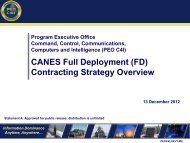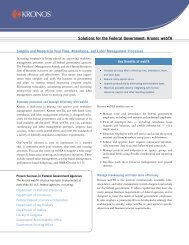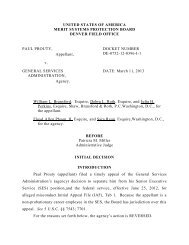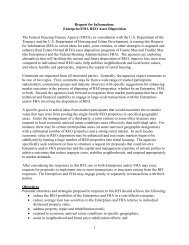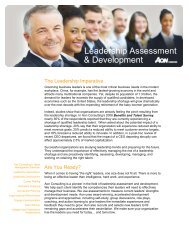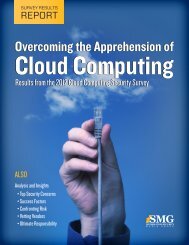Why change now? Preparing for the workplace of tomorrow - Deloitte
Why change now? Preparing for the workplace of tomorrow - Deloitte
Why change now? Preparing for the workplace of tomorrow - Deloitte
You also want an ePaper? Increase the reach of your titles
YUMPU automatically turns print PDFs into web optimized ePapers that Google loves.
Key Concept: “Delink” Space from HeadcountBy implementing mobile technologies and migrating towards shared workspace environments, <strong>the</strong> WPoT will “de-link”physical space consumption from employee headcount. In o<strong>the</strong>r words, <strong>the</strong> addition <strong>of</strong> 100 new employees under <strong>the</strong>WPoT will not necessarily require 100 new workspaces.Our industry research indicates that between 30%-40% <strong>of</strong> physical workspaces (seats) are vacant at any givenmoment <strong>of</strong> a traditional business day. Using a more conservative analysis that counts seats that are vacant throughout<strong>the</strong> day presents a lower, but still significant number. For example, assuming that all employees work on location, andonly 10% <strong>of</strong> <strong>the</strong>m take advantage <strong>of</strong> a flexible work schedule arrangement, <strong>the</strong> current utilization <strong>of</strong> <strong>the</strong> agency’sworkspace would be about 86%. 3 This means that on any given day, nearly one 1 <strong>of</strong> 7 workspaces are vacant <strong>for</strong> <strong>the</strong>duration <strong>of</strong> <strong>the</strong> day. 4 Daily and seasonal fluctuations impact workspace demands, making it unlikely that <strong>the</strong> full 14% <strong>of</strong>unutilized workspace could be re-purposed. However, as <strong>the</strong> example below illustrates, capturing just a portion <strong>of</strong> <strong>the</strong>unutilized space could help achieve substantial cost savings.Key Concept: Space Reduction = Cost Savings Assuming 10% <strong>of</strong> an agency’s work<strong>for</strong>ce follows a 5/4/9 compressed work schedule, <strong>the</strong> current utilization <strong>of</strong> <strong>the</strong>agency’s workspace will be about 86%.What does this mean? Leveraging unutilized workspace could result in significant cost savings <strong>for</strong> <strong>the</strong> agency, as illustrated below using ahypo<strong>the</strong>tical 4,400-employee facility located in Washington DC. Assuming an industry average per seat cost <strong>of</strong> $12,000 5 and a standard seat rate <strong>of</strong> 110 percent <strong>of</strong> employeeheadcount, <strong>the</strong> facility would cost approximately $58 million to maintain each year. By eliminating 14% <strong>of</strong> <strong>the</strong> total space, <strong>the</strong> agency could realize a cost savings <strong>of</strong> $8.1M at <strong>the</strong> DC facility alone.Below are a few examples <strong>of</strong> federal and commercial organizations that have realized cost savings through workspacereduction strategies.3This is a conservative calculation which takes <strong>the</strong> following factors into consideration: vacation days, sick days, flexible work schedules, and telecommuting.4The estimated vacancy <strong>of</strong> 1 in 7 workspaces is conservative and does not account <strong>for</strong> <strong>the</strong> 5-10% vacancy rate that is typically incorporated into facility planning estimates.5Based on a national cost per seat average <strong>of</strong> $12,000-$15,000. This includes real estate rental costs (60%) and supporting operations and services costs (40%). It does notinclude <strong>the</strong> technology costs to outfit <strong>the</strong> end user or support day-to-day operations.<strong>Preparing</strong> <strong>for</strong> <strong>the</strong> <strong>workplace</strong> <strong>of</strong> <strong>tomorrow</strong> 6
The Cost Savings from Space Reduction are REALFederal Agencies• The United States Patent and Trade Office (U.S. PTO) - with over 4,000 employees’ teleworking at least one day aweek, <strong>the</strong> U.S. PTO relinquished about 47,000 square feet <strong>of</strong> <strong>of</strong>fice space, saving roughly $1.5 million in <strong>of</strong>fice rentalcosts. 6• The Treasury Inspector General <strong>for</strong> Tax Administration (TIGTA) - saved over $750,000 at its DC headquarters <strong>of</strong>ficeas a result <strong>of</strong> <strong>of</strong>fering telework opportunities to its employees 7Commercial Organizations• Citigroup implemented an Alternative Workplace Strategies (AWS) program that generated real estate cost savings<strong>of</strong> $64 million in 2008 alone, primarily through <strong>the</strong> elimination <strong>of</strong> 21,700 seats (or 4.45million square feet) <strong>of</strong> spacefrom its global real estate portfolio. Citigroup projects that <strong>the</strong> AWS program is on track to eliminate an additional26,000 seats resulting in a $403 million run rate reduction in real estate costs by 2011 8 .With <strong>the</strong> passage <strong>of</strong> <strong>the</strong> 2009 American Economic Recovery and Reinvestment Act, many agencies anticipate hiringnew pr<strong>of</strong>essionals. Under <strong>the</strong> current <strong>workplace</strong> construct at most federal agencies, this hiring surge or a work<strong>for</strong>cereduction can result in ei<strong>the</strong>r a significant increase in <strong>the</strong> real estate and facility costs required to provide a physicalworkspace <strong>for</strong> <strong>the</strong> new personnel, or a significant increase in vacant, unutilized space. However, <strong>the</strong> WPoT wouldenable an agency respond to <strong>the</strong> employee surge or reduction in a more cost-effective manner, by realigningappropriate workspace type and seat sharing ratio based on <strong>the</strong> work grouping and mobility attributes <strong>of</strong> each jobfunction. The WPoT can provide <strong>workplace</strong> solutions that optimize space utilization and accommodate employees at asignificantly lower cost to agencies.Figure 3 below provides a graphical depiction <strong>of</strong> how <strong>the</strong> benefits <strong>of</strong> <strong>the</strong> new WPoT are distributed between <strong>the</strong> twoprimary components <strong>of</strong> technology and physical workspace.6Conference: Telework in a Box, February 26, 2009.7“Agency sees gains from telework imitative,” Government Executive, April 15, 2003.8Source 2009 CoreNet GlobalSummit Dallas 26-28 April 2009. Topic: Reducing Your Global Portfolio Cost: An Alternative Workplace Program at Citigroup<strong>Preparing</strong> <strong>for</strong> <strong>the</strong> <strong>workplace</strong> <strong>of</strong> <strong>tomorrow</strong> 7
Figure 3: Sources <strong>of</strong> WPoT BenefitsOptimize TechnologyImproved DesktopReduce Physical WorkspaceVirtual OfficeProductivity GainsCost SavingsRationalization EfficienciesWork<strong>for</strong>ce AgilityAgencies that adopt WPoT concepts achieve <strong>the</strong> majority <strong>of</strong> productivity and efficiency gains through <strong>the</strong> roll-out <strong>of</strong>modern technologies (e.g., improved laptops, PDAs, VoIP, etc.) across <strong>the</strong> enterprise. Alternatively, <strong>the</strong> majority <strong>of</strong><strong>workplace</strong> cost savings and improved work<strong>for</strong>ce agility are realized through <strong>the</strong> more effective use <strong>of</strong> space (e.g.,reducing need <strong>for</strong> <strong>of</strong>fice space through <strong>the</strong> implementation <strong>of</strong> a shared workspace environment).Critical Success Factors <strong>for</strong> Designing and Implementing <strong>the</strong> WPoTAn agency’s ability to successfully implement <strong>the</strong> WPoT hinges on a number <strong>of</strong> key factors including: Cross-Functional Integration. Migrating to <strong>the</strong> WPoT will result in multiple dimensions <strong>of</strong> <strong>change</strong> across <strong>the</strong> RealEstate, HR, IT, and Finance functions. As a result, agencies must adopt a multi-disciplinary approach that takes aholistic view <strong>of</strong> <strong>the</strong> <strong>workplace</strong> and integrates <strong>the</strong>se four enabling functions when designing and implementing <strong>the</strong>WPoT. Strong Stakeholder Engagement. All stakeholders, including representatives from employee unions / collectivebargaining units need to be identified and included in <strong>the</strong> processes from <strong>the</strong> outset. Commitment to Invest in Mobile Technologies, Web 2.0 Tools, and Workspace Management Solutions.Shared workspace environments require a laptop-based work<strong>for</strong>ce, and access to portable telecommunications(ei<strong>the</strong>r VoIP or PDAs). Workers adopting telecommuting arrangements will benefit from Web 2.0 collaboration tools,and will also require <strong>the</strong> laptop/PDA equipment with remote connectivity and <strong>the</strong> appropriate s<strong>of</strong>tware to allow secureaccess to <strong>the</strong> agency’s intranet. Implementing <strong>the</strong> WPoT will also require <strong>the</strong> use <strong>of</strong> workspace managementsystems that enable personnel to identify <strong>the</strong>ir preferred worksite/workspace and make reservations in advance.Agencies must be willing to make <strong>the</strong>se investments and embrace <strong>the</strong> technologies required to support a WPoTmodel. In addition, existing initiatives <strong>for</strong> <strong>the</strong>se types <strong>of</strong> technology need to be optimized to support <strong>the</strong> WPoT ef<strong>for</strong>t. Effective Work<strong>for</strong>ce Analysis. Current and projected work<strong>for</strong>ce data must be analyzed to develop work<strong>for</strong>cegroupings based on job functions, job levels, and attributes <strong>of</strong> employee mobility. Under <strong>the</strong> WPoT, <strong>the</strong>se work<strong>for</strong>cegroupings will be used to define appropriate workspace solutions <strong>for</strong> <strong>the</strong> work<strong>for</strong>ce, including designating spacetypes (e.g., conventional, telecommute, hoteling, satellite <strong>of</strong>fice, etc.) and sharing ratios (employees per seat).Effective work<strong>for</strong>ce analysis will also be useful in: Optimizing in-flight technology initiatives – <strong>for</strong> instance, some agencies may already be considering outfitting allemployees with laptops as a first step in <strong>the</strong> move towards a more virtual work<strong>for</strong>ce. An assessment <strong>of</strong> work<strong>for</strong>cesegments as part <strong>of</strong> designing <strong>the</strong> WPoT will help to evaluate and optimize <strong>the</strong> significant technology costsassociated with this policy.<strong>Preparing</strong> <strong>for</strong> <strong>the</strong> <strong>workplace</strong> <strong>of</strong> <strong>tomorrow</strong> 8
Identifying highly mobile segments <strong>of</strong> <strong>the</strong> work<strong>for</strong>ce that could be used <strong>for</strong> a pilot roll-out <strong>of</strong> <strong>the</strong> WPoT – <strong>for</strong>instance, if one group <strong>of</strong> employees represents a highly mobile segment <strong>of</strong> <strong>the</strong> work<strong>for</strong>ce, that group could betargeted as a pilot population <strong>for</strong> roll-out <strong>of</strong> <strong>the</strong> WPoT concept. Designing a roll-out strategy <strong>for</strong> <strong>the</strong> implementation plan – <strong>for</strong> instance, new employees should be immediatelyassigned a workspace solution under <strong>the</strong> WPoT based on <strong>the</strong>ir work groupings. However, current employeeswhose work groupings fit non-conventional space designations (e.g., telecommute, hoteling) should be given <strong>the</strong>option to transition out <strong>of</strong> <strong>the</strong>ir existing workspaces to <strong>the</strong> new WPoT designated workspaces. The transitionoptions presented to this group <strong>of</strong> employees should include incentives that will require employees to accept <strong>the</strong>new physical workspace sharing ratios <strong>for</strong> access to new mobile technologies that are designed to boostproductivity and per<strong>for</strong>mance. Incorporation <strong>of</strong> Enterprise-wide Sustainability and Greening Initiatives. It is no longer a question <strong>of</strong> “if,” butra<strong>the</strong>r “when” government agencies will need to begin adopting stricter green <strong>workplace</strong> standards. Private sectororganizations are taking <strong>the</strong> lead, state and local jurisdictions are following suit, and federal agencies are increasinglybeing pressured to identify ways to reduce <strong>the</strong>ir overall carbon footprint. Government is quickly realizing that goinggreen isn’t purely an altruistic ef<strong>for</strong>t; it can save an agency enormous amounts <strong>of</strong> money and lead to loweroperational risk, increased employee productivity, and enhanced public image.Greening = Cost Savings + Reduced Carbon FootprintGreening can significantly lower IT overhead costs, particularly <strong>the</strong> cost <strong>of</strong> energy use. As agencies become aware <strong>of</strong><strong>the</strong> true cost <strong>of</strong> IT, CIOs will be expected to address and report on energy consumption.Greening can also have a significant impact on <strong>the</strong> carbon footprint <strong>of</strong> agencies and individuals: Buildings make up 39% <strong>of</strong> US carbon emissions each year. 9 Even small efficiencies in workspace utilization can addup to major environmental benefits. Initiatives like AWS and telecommuting can have big impacts on <strong>the</strong> carbon footprints <strong>of</strong> individuals. With commutingmaking up 10-20% 10 <strong>of</strong> an individual’s carbon footprint, a 5/4/9 schedule, and one day a week telecommuting canresult in a 3-6% 11 reduction in carbon emissions. The Workplace <strong>of</strong> <strong>the</strong> Future at <strong>Deloitte</strong> LLP resulted in a 30% reduction in square footage per employee and a 30%associated savings in energy costs — a savings <strong>of</strong> over $100 million per year within 2.5 years <strong>of</strong> implementation at<strong>Deloitte</strong> LLP.Agencies have a number <strong>of</strong> opportunities to incorporate green initiatives into <strong>the</strong> WPoT. Reducing carbon footprint andmaking facilities more efficient are <strong>the</strong> biggest and most obvious ef<strong>for</strong>ts. Buildings alone are responsible <strong>for</strong> 39% <strong>of</strong> allgreenhouse gases emitted in <strong>the</strong> U.S. 12 and <strong>the</strong> WPoT can result in a reduction in <strong>the</strong> amount <strong>of</strong> work space peremployee from an industry average 250 sq. ft. to 150 sq. ft. or less. This decrease in an agency’s leased and ownedspace means that fewer natural resources are consumed to construct, maintain, and operate buildings, and lower realestate and facility cost. The strategy can also <strong>of</strong>fer workers more natural light, better quality, and improved acoustics. 13In addition, employees commuting to work make up between 10 and 20% <strong>of</strong> an individual’s carbon footprint, dependingon <strong>the</strong> vehicle. A WPoT ef<strong>for</strong>t can provide flexible work arrangements and more efficient use <strong>of</strong> facilities, resulting insubstantial reductions to both corporate and individual carbon emissions.9U.S. Green Building Council. http://www.usgbc.org/DisplayPage.aspx?CMSPageID=124.10The 2003 Bureau <strong>of</strong> Transportation Statistics Report found that <strong>the</strong> average U.S. commute was 32 miles round trip, producing 2.3 to 6.5 tons <strong>of</strong> carbon annually. EPA inventories<strong>of</strong> U.S. greenhouse emissions estimate <strong>the</strong> average footprint to be 23 tons per capita annually.11“Green Building Costs and Financial Benefits” and “The Costs and Financial Benefits <strong>of</strong> Green Buildings: A Report to Cali<strong>for</strong>nia’s Sustainable Building Task Force,” 2003, GregoryH. Kats, Capital E (www.cap-e.com).12U.S. Green Building Council. http://www.usgbc.org/DisplayPage.aspx?CMSPageID=124.13“Corporate Real Estate Goes Green: Generating Shareholder Value, Boosting ROI and Protecting <strong>the</strong> Environment”, Corporate Real Estate Leader magazine, July, 2007<strong>Preparing</strong> <strong>for</strong> <strong>the</strong> <strong>workplace</strong> <strong>of</strong> <strong>tomorrow</strong> 9
Representative Case StudiesCase Study:Designing and Implementing a GlobalAlternative Workplace StrategyCompany:Global Financial Services CompanyA large global financial services company that experienced significantdeclines in its earnings as a result <strong>of</strong> <strong>the</strong> sub-prime mortgage collapseasked <strong>Deloitte</strong> to help <strong>the</strong>m in <strong>the</strong>ir ef<strong>for</strong>ts to plan and develop <strong>the</strong>irAlternative Workplace Strategy (AWS) program. The primary goals <strong>of</strong><strong>the</strong> initiative were three-fold: (1) to reduce real estate occupancy costs;(2) to improve employee productivity, retention, and commitment; and(3) to enhance customer relations and business continuity.Key project activities included conducting an employee pr<strong>of</strong>ile analysisto identify target user groups that would embrace AWS, as well asper<strong>for</strong>ming analysis on <strong>the</strong> company’s global real estate portfolio toidentify potential opportunities <strong>for</strong> cost savings. Additionally, weassisted with <strong>the</strong> development <strong>of</strong> <strong>the</strong> implementation approach andtools. Expected benefits <strong>of</strong> <strong>the</strong> project include cost reduction over <strong>the</strong>long term, improved levels <strong>of</strong> facility service, enhanced businesscontinuity, and improvements in employee productivity, retention, andcommitment.Case Study:Building an Opportunity Business Caseand Designing a Global WorkplaceStrategyCompany:Global Life Sciences CompanyCase Study:Designing a Workplace <strong>of</strong> <strong>the</strong> FutureProgramCompany:Global Pr<strong>of</strong>essional Services FirmDriven by cost pressures and an overall cultural <strong>change</strong>, a global lifesciences company asked <strong>Deloitte</strong> to help <strong>the</strong>m in <strong>the</strong>ir ef<strong>for</strong>ts to build across-functional Advanced Workplace Management (AWM) team to: (1)develop a <strong>workplace</strong> strategy that would significantly reduce <strong>the</strong>company’s cost structure; and (2) rein<strong>for</strong>ce a culture <strong>of</strong> innovation andteamwork with a focus on results.The project team worked closely with stakeholders from across <strong>the</strong>organization to develop an integrated flexibility, mobility, and workspacesolution that included new HR, IT, and space guidelines. This solutionwas implemented initially across <strong>the</strong> company’s major U.S. campuses,encompassing approximately 20,000 U.S. employees. Theimplementation <strong>of</strong> <strong>the</strong> new <strong>workplace</strong> strategy rein<strong>for</strong>ced <strong>the</strong> company’scultural direction and enabled a reduction in physical footprint with$130M in ongoing annual cost savings.<strong>Deloitte</strong> helped a Big 4 Firm occupying over 7M square feet <strong>of</strong> spaceacross <strong>the</strong> U.S. with <strong>the</strong>ir ef<strong>for</strong>ts to significantly reduce <strong>the</strong>ir coststructure and rein<strong>for</strong>ce a culture <strong>of</strong> collaboration, innovation, andteamwork. <strong>Deloitte</strong> provided support to three main activities: (1)developing a deep understanding <strong>of</strong> <strong>the</strong> company’s <strong>workplace</strong>requirements; (2) detailing a set <strong>of</strong> components <strong>for</strong> a <strong>workplace</strong> strategythat could support <strong>the</strong> company’s ef<strong>for</strong>ts to refocus its culture; and (3)developing a <strong>change</strong> management plan that was supported by all levelsacross <strong>the</strong> organization.This initiative resulted in <strong>the</strong> development <strong>of</strong> <strong>the</strong> Workplace <strong>of</strong> <strong>the</strong>Future (WOF), and its implementation in 6 United States locationsyielded a cost avoidance <strong>of</strong> ~$30M in capital expenditure in <strong>the</strong> firstyear.<strong>Preparing</strong> <strong>for</strong> <strong>the</strong> <strong>workplace</strong> <strong>of</strong> <strong>tomorrow</strong> 10
Contact In<strong>for</strong>mationFor questions on <strong>the</strong> Workplace <strong>of</strong> Tomorrow please contact:Seth SiegelDirector<strong>Deloitte</strong> Consulting LLPTel: +1 (202) 758-1080E-mail: ssiegel@deloitte.comNaomi LeventhalDirector<strong>Deloitte</strong> Consulting LLPTel: +1 (202) 220-2739E-mail: naleventhal@deloitte.comRob DaneggerSenior Manager<strong>Deloitte</strong> Consulting LLPTel: +1 (202) 378-5153E-mail: rdanegger@deloitte.comFrancisco AcobaSenior Manager<strong>Deloitte</strong> Consulting LLPTel: +1 (212) 618-4432E-mail: facoba@deloitte.comUchenna AmaonwuManager<strong>Deloitte</strong> Consulting LLPTel: +1 (202) 220-2893E-mail: uamaonwu@deloitte.comFor questions on Talent Strategies and Solutions please contact:Jeff SchwartzPrincipal<strong>Deloitte</strong> Consulting LLPTel: +1 (703) 251-1501E-mail: jeffschwartz@deloitte.comAndy LiakopoulosPrincipal<strong>Deloitte</strong> Consulting LLPTel: +1 (312) 486-2777E-mail: aliakopoulos@deloitte.comThis publication contains general in<strong>for</strong>mation only and is based on <strong>the</strong> experiences and research <strong>of</strong> <strong>Deloitte</strong> practitioners. <strong>Deloitte</strong> is not, by means <strong>of</strong> this publication,rendering business, financial, investment, or o<strong>the</strong>r pr<strong>of</strong>essional advice or services. This publication is not a substitute <strong>for</strong> such pr<strong>of</strong>essional advice or services, nor shouldit be used as a basis <strong>for</strong> any decision or action that may affect your business. Be<strong>for</strong>e making any decision or taking any action that may affect your business, you shouldconsult a qualified pr<strong>of</strong>essional advisor. <strong>Deloitte</strong>, its affiliates, and related entities shall not be responsible <strong>for</strong> any loss sustained by any person who relies on thispublication.As used in this document, “<strong>Deloitte</strong>” means <strong>Deloitte</strong> Consulting LLP. Please see www.deloitte.com/us about <strong>for</strong> a detailed description <strong>of</strong> <strong>the</strong> legalstructure <strong>of</strong> <strong>Deloitte</strong> LLP and its subsidiaries.Copyright © 2009 <strong>Deloitte</strong> Development LLC. All rights reserved.Member <strong>of</strong> <strong>Deloitte</strong> Touche Tohmatsu




